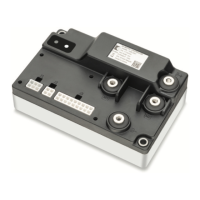APPENDIX B — EN 13849 COMPLIANCE,CURTIS 1226 CONTROLLER
pg. 89
Return to TOC Curtis Model 1226 – September 2019
Curtis has analyzed each safety function and calculated its Mean Time To Dangerous Failure
(MTTFd) and Diagnostic Coverage (DC), and designed them against Common Cause Faults (CCF).
e safety-related performance of the Curtis 1226 is summarized in Table 34:
Table 34 Safety Performance
Safety Function
Performance
Level (PL)
Designated
Architecture
MTTFd DC
Uncommanded Powered Movement and
Motor Braking Torque
c Category 2 ≥ 16 years ≥ 90%
EN1175 specifies that traction and hydraulic electronic control systems must use Designated
Architecture 2 or greater. is design employs input, logic, and output circuits that are monitored
and tested by independent circuits and soware to ensure a high level of safety performance (up to
PL=d).
Mean Time To Dangerous Failure (MTTFd) is related to the expected reliability of the safety related
parts used in the controller. Only failures that can result in a dangerous situation are included in the
calculation.
Diagnostic Coverage (DC) is a measure of the eectiveness of the control system’s self-test and
monitoring measures to detect failures and provide a safe shutdown.
Common Cause Faults (CCF) are so named because some faults within a controller can aect
several systems. EN13849 provides a checklist of design techniques that should be followed to achieve
sucient mitigation of CCFs. All circuits used by a safety function must be designed in such a way
as to score 65 or better on the CCF score sheet as provided by EN13849 table F.1.
Performance Level (PL) categorizes the quality or eectiveness of a safety channel to reduce the
potential risk caused by dangerous faults within the system with “a” being the lowest and “e” being
the highest achievable performance.
Contact Curtis technical support for more details.

